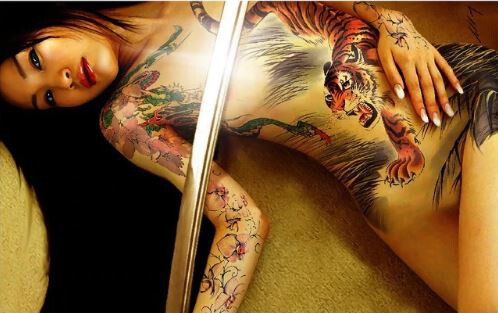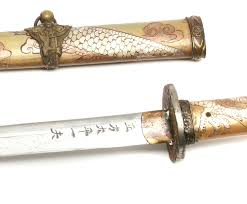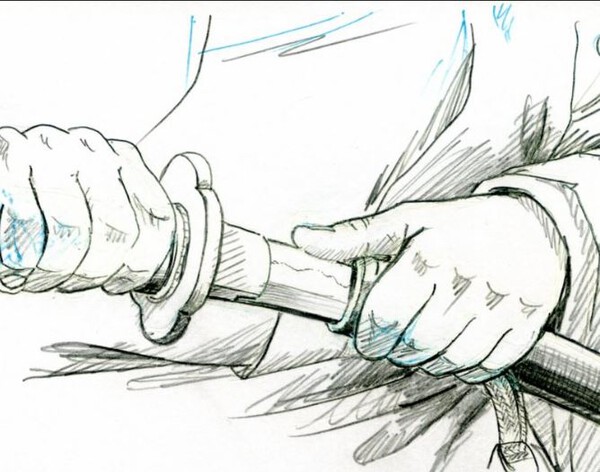-
Posts
3,242 -
Joined
-
Days Won
99
Content Type
Profiles
Forums
Events
Store
Downloads
Gallery
Everything posted by Guido
-
Uhm, different kanji (河野 instead of 川野) ...
-

Honjo Masamune found!! (well almost... maybe)
Guido replied to Adrian S's topic in General Nihonto Related Discussion
-

Honjo Masamune found!! (well almost... maybe)
Guido replied to Adrian S's topic in General Nihonto Related Discussion
There are no kanji for "water", "no", "cut", "sword", "tender", and "mune" in 正方太平一夫; it means - not literally, though - "made in China". P.S.: Oops, I missed Steve's reply, he was a little faster than me. -
I couldn‘t wrap my head around it, but yes, that indeed makes sense - good thinking, Ray!
-
I think it's technically impossible to have a double orikaeshi-mei - my guess is that's it a tanzaku-mei inlayed in a fashion to make it look like orikaeshi. Or maybe a combination of orikaeshi and tanzaku mei.
-
6,000 Yen for licensing and 25,000 Yen shinsa fees = 31,000 Yen (US$ 286): I didn't know that Paul charges a 619,000 Yen (US$ 5,700) handling fee ....
-
Luca, mon doesn't necessarily mean kamon, it can be any (repetitive) pattern. However, in this case I don't agree with the description in the papers: I think both your's and Bruno's tsuba depict (stylized) pine trees.
-
Doug, I think Greg is reacting to a post in another thread where our resident gossip and rumor-spreader was at work again: a sad case of trying to appear to be in the know by constantly making unsubstantiated, attention seeking claims. Not contributing anything of substance, but always being there to grace us with his “insider knowledge” of the workings of the Japanese sword market. When called out, he keeps quite until he finds another topic he can barge in.
-
雛刀 = hinagatana = minature sword for children
-

Help/advice With A Potential Purchase
Guido replied to nickm's topic in General Nihonto Related Discussion
Well, where do you draw the line? How about having a sword polished - another case of preservation vs. restoration? I hope my questions were provocative enough to snap you out of your slightly intoxicated state ... -
By definition, a hagire can only occur in the ha (hence *ha*gire). This is a welding flaw - not desirable, but I also wouldn't loose any sleep over it.
-
100% Chinese, and square(ish) tsuba are not uncommon. What else do we learn from this? Don't buy drill bits made in China ...
-
The two examples I posted above were photoshopped by me to illustrate my point - I‘m talking about 90 degrees. If you google 薙刀鞘, you‘ll find quite a few pictures that show both orientations. Sorry if I wasn‘t more precise.
-
A question for the polearm experts: While the orientation of kamon on yari-saya seems to be always upwards (i.e. when the yari is held vertically), on naginata-saya I’ve seen both upwards and sidewards (i.e. if the naginata is held horizontally) pointing kamon. I don’t have much literature on polearms, but there seems to be historical evidence for both. Are there any rules for this?
-
I appreciate your candor, but there are things we really don't need to know ...
-
When writing N ン, the long stroke starts at the bottom, with SO ソ at the top; I think the katakana in the photo is a SO.
-
We often see in jidai geki (period dramas) how samurai put a bloody thumb-print seal (血判 keppan) below their name on a document in order to strongly express sincerity about the content; this was done on petitions, vows, confidential agreements, and so on. For instance, Ōishi Kuranoske (the leader of the 47 ronin) wanted to confirm the members' commitment by asking them to return their pledges blood-sealed. The method shown in movies and on tv is that the wakizashi is pulled out of its saya a few inches, and the left thumb is pressed down on the edge. I always wondered why it was done that way, besides looking really cool, of course . We all know how many nerve endings our fingertips have, and how painful it is to get a cut there; it also takes forever to heal. And from a more practical standpoint, one gets blood on the blade, and might be impaired to handle a sword properly with the injured thumb. While going through the book 日本刀の総合美 nihontō no sōgōbi by 飯山嘉昌 Iiyama Yoshimasa, I found out that we’re indeed – and again - a victim of Hollywood (or, in this case maybe Tōei Studios): in reality the kozuka/kogatana was used to make a small cut on the top of the ring finger, and then the thumb was put on the wound to transfer the blood. Kind of cumbersome, and completely lacking the coolness factor, but makes perfect sense.
- 13 replies
-
- 15
-

-
政美 = Masayoshi (at age 69)
-
I haven't seen a single hozon or tokubetsu hozon paper for sale here - they have to be handed in when applying for higher papers. Unless, of course, a sword is submitted multiple times for the same level without disclosing the previous papers, and the shinsa team doesn't recognize it. But it would be pretty idiotic to invest a couple of hundred $ in order to make $ 10 from selling the papers ...
-
eBay doesn't care as long as they get their percentage of the sale, and are not in violation of any law. The use for fraud of those obsolete, green papers is limited anyhow. Even here in the f/s section of the NMB were "old" papers without items sold not that long ago ...
-
Sebastien, this is the stuff I use: https://www.amazon.co.jp/gp/product/B012NCWTL0/ref=oh_aui_detailpage_o00_s00?ie=UTF8&psc=1 It's made of rayon, stretches nicely, doesn't do any harm to the fittings, and is much cheaper than real silk. However, it's a little thicker than regular chirimen, so it might not be ideal for intricate molding, like menuki.
-
John, here's a breakdown of the kanji: 頭 (kashira) zu = head 形 (kata) nari = shape 座星 zaboshi = "seated" star 天谷山 = heaven & valley & mountain. "Tenkokuzan" seems to be a special, armor related reading, I would have pronunced 天谷 “amaya” or “amadani”.
-
Steven is right, those are wild geese and a full moon, a classic Japanese motif used in wooblock prints, paintings, sword fittings, poems, and so on. Kobayashi Issa, a prolific poet, liked geese so much that he wrote 448 haiku about them .
-
By coincident I just found a similar kabuto in an exhibition catalog of the historical society of Izumi township. It is described as a zaboshizunarikabuto 座星頭形兜, Momoyama period.










